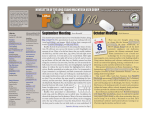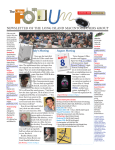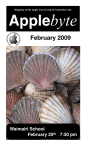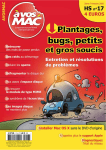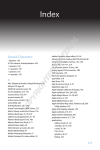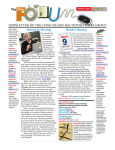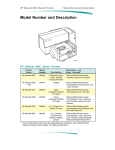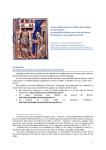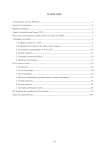Download May Meeting April Meeting - Long Island Mac Users Group
Transcript
M 2009 YEARS ROUP 25 SG 1984 AC IN ER LON SLAND GI TOSH U S NEWSLETTER OF THE LONG ISLAND MACINTOSH USER GROUP April Meeting Donald Hennessy A not-for-profit, volunteer, member-supported organization www.limac.org This month we will play host to Lesa Snider , author of Photoshop Y CS4: The Missing Manual. The MA multi-talented Lesa, a well known author, magazine contributor, graphics educator and corporate trainer will demonstrate editing digital photos and creating documents with the premier image editing software application, Adobe Photoshop CS4. Lesa spent many, many months before the software’s release writing what is sure to become one of the standard references for Photoshop CS4, receiving high praise from none other than Photoshop Insider’s Scott Kelby, “…it is the new Photoshop Bible. Way to go Lesa!” As usual, the meeting begins with the two Q&A sessions followed by the main presentation. Next come announcements and the rafffle, then the SIG sessions round out the meeting. This month is sure to be a real crowd pleaser, so make sure you’re one of the crowd! 0 8 Photo: Harold Silver MAY 2009 May Meeting LIMac Inc. Rick Matteson April’s presentation featured Tom Abruzzo from the Walt Whitman Apple Store. It is always a treat to have Tom as a presenter, because he not only shows the product’s features, but exactly what you can do with each of them. This time Tom showed the new iWork ’09. I am presently using the suite, (in fact I am using it to write this review) and many of Tom’s tips were quite welcome. Tom started by showing the Pages word processing module (as many of you know, it also includes a page layout module). The first thing Tom showed was the many templates included in Pages. These are basically pages set up with a lot of place holders, so you don’t have to bother with formatting, to include such things as; addresses and phone numbers. You can remove what is there and later insert your own information without having to adjust the formatting. Next Tom showed how to use the contextual formatting bar. This allows you fine control over spacing, font size, style, alignment and more. Next Tom showed how to include a picture (or graphic) in your document. In addition he showed the many effects that can be added to your picture such as: drop shadow, reflection, and even a border. Tom also showed how (and when) to use instant alpha to remove the background of a photo or graphic. You can then wrap text around it, or place it in a background you create. Next on the menu was Keynote. Interestingly he went from Pages to Keynote because there was a theme to his presentation. It was starting a business. First, letterhead created in Pages, and then a presentation created in Keynote. He demonstrated how to make the presentation, add graphics, add builds (effects on single slide) and transitions (effects from slide to slide), and even add graphs created in Numbers. April Meeting continued on Page 7 P.O. Box 2048 Seaford, NY 11783-0180 President Bill Medlow archbill@ optonline.net Vice President George Canellis LIMac was established in 1984, when the Mac was introduced. Annual dues for membership are $36. (The first meeting is free.) For information, contact any of the following: Membership gwc11713@ optonline.net Donald Hennessy Treasurer aboutlimac@ aol.com Donald Hennessy Technical Advicer aboutlimac@ aol.com Bradley Dichter Secretary [email protected] Bernie Flicker twoflick@ optonline.net The LIMac Forum: Editor/Graphics Al Zygier [email protected] Board of Directors: Geoff Broadhurst George Canellis Al Choy Bradley Dichter (Technical Director) Bernie Flicker Donald Hennessy Richard Hickerson Rick Matteson (Program Coordinator) Bill Medlow Scott Randell Brian Revere Albert Zygier Program Coordinator Rick Matteson rgmlimac@ optonline.net Photoshop SIG Brian Revere brevere@ optonline.net MacBasic SIG Geoff Broadhurst gahoof@ optonline.net Multimedia SIG Al Zygier azygier@ nyc.rr.com Produced using: Adobe’s InDesignCS3, PhotoshopCS3, IllustratorCS3. Acrobat 8 Fonts are: ITC’s Officina Sans and Galliard Pro Impact, Kidprint The Forum is published monthly by LlMac. All contents, except where noted, are copyright ©2009 by LIMac. Opinions expressed are the views of the authors and do not necessarily reflect those of LIMac. Contents may be reprinted for non-commercial use, with due acknowledgment to LIMac. The LIMac Forum is an independent publication and has not been authorized, sponsored or otherwise approved by Apple Computer, Inc. Bradley’s Tech Session General meeting time schedule: Meetings are held at The New York Institute of Technology, Building 300 (Anna Rubin Hall), Old Westbury, Long Island. Meetings start promptly at 7:00 p.m. Bradley’s Q&A: 7:00 – 7:30 p.m. MacBasics Q&A: 7:00 – 7:30 p.m. More on iWork: working with and modifying templates in Pages; a brief look at Numbers; creating a simple presentation with Keynote. Featured Presentation: 7:30 – 8:20 p.m. followed by announcements and raffle drawings. SIG Meetings: (Special Interest Groups) DTP/Photoshop SIG 2009: 8:30 – 10:00 p.m. The Mac Coloring Book: Create a line drawing from a photo and color it again like a kids coloring book. | In bad weather, call (516) 686-7789. | The next LIMac board meeting will be at the Plainedge Library, (516) 735-4133, on Wednesday, February 18th, at 7:45 p.m. 2 THE LIMAC FORUM/MAY 2009 Bradley Dichter Technical Advisor [email protected] | Do you need to defragment your hard drive? I heard the Mac operating system does this for you. And if so, how can you do that? ■ Most people don’t need to. For those who need to know more, I’ll elaborate: Say you create a new text document as you start a term paper, and call that Chapter 1. Then you create and save a second file, called Chapter 2. Later you do back to add more text to Chapter 1. The new text has to be saved to disk after the Chapter 2 data as Chapter 1 was constrained to a small allocation block of disk space. (A allocation block is the smallest portion of the disk a file can take up, even if not all of it is actually in use. You may see a 62 byte alias taking up 4 KB because of the allocation block size.) So the Mac OS X keeps track of these ‘extents’ for each little piece of your files, which can get longer and longer as you edit random files. The problem with a fragmented file is two-fold. If there is extensive directory damage, a fragmented file cannot be recovered as the Mac cannot locate the various pieces (extents) of the file. Perhaps a bigger problem for time sensitive audio and video editors is the time it takes for the hard drive to seek the various parts as the file is loaded into memory. Ever since Mac OS 10.2, the system has had delayed allocation which combined a number of small disk allocations into one larger allocation thus avoiding some fragmentation. Also since Mac OS 10.3 (Panther) the system has had hot file adaptive clustering which will defragment slowgrowing files. It will transparently defragment files smaller than 20 MB and broken into eight or more pieces as the file is opened. Many modern applications will rewrite your data files as they are saved rather than appending new data which will avoid fragmentation as well. Of course your hard drive is mostly filled with static small files, perhaps parts of application packages. You could easily get these non-user files fragmented by an updater program. Still the graphic, audio and video professionals who make large files can benefit from defragmenting or optimizing their hard drive’s files and the free space around them. Say you were running low on disk space on your startup drive and Photoshop is reporting that the scratch disk is full, so Bradley’s Tech Session continued on Page 3 President’s Message Bill Medlow President [email protected] LIMac has a number of great presentations that will be running through the summer months. Just check out our web site calendar by looking under the Monthly heading for the calendar http://www.limac.org/calendar.html. Computer software only gets bigger, better, faster, more elegant and consume more of your time and it changes every 16 months. This is probably why so many members still use AppleWorks. In the April meeting, Tom Abruzzo showed us how we could use the suite of applications called iWork ’09. This is composed of Pages ’09 (word processing), Numbers ’09 (spreadsheet) and Keynote ’09 (presentation). It is much easier to use than Microsoft Word and possibly more efficient for just writing a letter. For getting the word out, do you really need that 900 pound gorilla? It imports and exports all the big stuff. Try it, you may like it. Don’t miss these meetings! 0 DAN DANGLO from Bradley’s Tech Session Bradley’s Tech Session continued from Page 2 you delete some files to free up more space, but Photoshop still complains. This is because Photoshop needs contiguous free space, and your free space is scattered around the hard drive. Even everyday people can take advantage of a defragmented large file. My Microsoft Entourage (email) database is 5.57 GB and fragmented. It takes a fair amount of disk accessing when I do a search. You can see a pause as you scroll through your Microsoft Word file you’ve been working on for 20 years. You cannot properly optimize the free space on your drive while you are booted up off it, so you need to boot either from another partition or drive with a System on it, or the CD/ DVD that one of the utilities comes on. As I’ve said Apple doesn’t include any software for this task, so you have to buy either the $35 one-trick iDefrag from Coriolis Systems, or the defragment function of either Micromat’s TechTool Pro 5.0.4 or Prosoft Engineering’s Drive Genius 2.1.1 or Intech Software’s SpeedTools Utilities. (I think Intech is out of business now.) Some of you may be familiar with TechTool Deluxe which comes with a AppleCare Protection Plan, but that limited version lacks this and many other functions of the Pro version (which you can upgrade to for $59). Folks with much older systems used to rely on the Speed Disk application part of Norton Utilities and the SystemWorks bundle. Switchers to the Mac from Windows are surprised to not find a defragmentation program, as Windows has had Diskeeper since Windows 2000. Microsoft licensed it from Executive Software as it was the most popular third party program of this type back then. Norton’s SpeedDisk also was popular. The optimization process, if interrupted, could ruin your data, so make sure you have a complete backup with SuperDuper!, Carbon Copy Cloner or Time Machine first. Some of these programs have two different procedures, one for file fragmentation which combines all the various segments of each file into one spot on the drive and another for disk defragmentation which combines all the files into one block so that the free space is now in a second contiguous block. This is the second step that may be most important to Photoshop’s needs. In any case, you would probably be booting off the utilities CD or DVD and optimizing your startup disk. You should use one of the suite’s directory repair functions first and then perform the file and disk optimizations. With many terabytes of Good Morning, data, this will take a very long time, so be prepared to start this before you go to sleep. | Would you advise the average web surfing and email kind of user to not defragment since the potential for disaster is so great? It seems a lot of switchers from the PC realm were indoctrinated to doing this regularly. ■ No. Heck I don’t do it regularly. I’d guess the average nonswitcher is not aware of the minor problem and doesn’t want to know. Of course many basic users don’t have a backup of their files and even more don’t have a battery backup or UPS to keep their computer alive and well and their data safe. With no included software from Apple, they assume it is not required and leave the issue at that. I don’t recommend periodic defragmenting to most of my clients in that class. The graphic artists and video folks know about fragmentation and will fix it as needed, maybe once or twice a year if they are very concerned about the issue. With disk capacities and CPU speeds as they are nowadays, it’s less of an issue then it once was. Even if you have a disk and a battery backup and there were no bugs in the defragmenter software, the speed improvement to be gained is usually not worth the time to run the software. | I have a 2.8 GHz iMac. Can it be used a server? ■ Yes. You can install Mac OS X Server software, replacing the normal client version of Mac OS X or you can leave the client version, use the personal Web Sharing function from Apple or install any of the dedicated web server applications like Abyss Web Server, Apache, LiteSpeed Web Server or Roxen WebSever. The oldest (since 1995) http server for the Mac was StarNine’s WebSTAR, which became 4D WebSTAR Server Suite and then Kerio WebStar and discontinued last year. I’d say start with what is free and there already with the included Apache 2.2.6 server and the PHP 5.2.6 server. read this outdated 6 part article from O’Reilly’s macdevcenter at http://www. onlamp.com/pub/ct/49 which is detailed. This was also useful: http://www.superfancy.net/coding/php-mysql-apache-in-mac-osxleopard/ Your iMac should have a static IP address and your home router would need to set port forwarding of HTTP port 80 traffic to it. Ideally you should get a static IP address from your Internet provider and register a domain name and have it point to your static IP address. Configure your router to for- I have set-up a discount code for your group to be used for the EOS Essentials Saturday Mini-Conference. Upon check-out participants can enter LIMAC0530 to receive a $25 discount that has no expiration date. The newsletter is below with general information. http://www.usa.canon.com/canonlivelearning It is sure to be a great day with Vince Laforet, Bob Davis, ICP instructor Carol Dragon and our pro rep Carl Peer. Thanks, Kristen Kristen Cunningham On-Site Education Canon USA One Canon Plaza Lake Success, NY 11042 (516) 327-8468 Bradley’s Tech Session continued on Page 4 THE LIMAC FORUM/MAY 2009 3 TIP! from http://db.tidbits.com/ Apple Adds Petite Aluminum Keyboard by Tonya Engst Apple last week released a new Apple Keyboard, which offers Apple’s sleek aluminum look and two extra USB 2.0 ports, but no numeric keypad. The keyboard costs $49 and requires that you be running at least Mac OS X 10.5.6 Leopard. In the recent past, if you wanted a small aluminum keyboard from Apple, you had to purchase the $79 Bluetooth-based wireless keyboard. It eschews a numeric keypad and suffers from the hassle of dealing with batteries and Bluetooth, though it does eliminate a cable from your life. The new Apple Keyboard is noteworthy for people buying a new iMac because it’s the default option when you shop from Apple. For the moment, though, you can substitute the Apple Keyboard with Numeric Keypad at no extra charge (the default situation is reversed for Mac Pro purchasers). For those buying a Mac mini, both keyboards cost the same. The Apple Wireless Keyboard costs an extra $30. The Mac Turns 25: Best Mac Ever? by Adam C. Engst When my friends at Macworld called and asked me to contribute to their 25th anniversary issue, I jumped at the chance. Steve Jobs is so uninterested in the past that he had Apple’s famous icon garden not only ripped out, but junked. I, on the other hand, find it instructive to pay attention to the past because it both informs where we are today and, hopefully, enables us to avoid repeating our mistakes. TidBITS continued on Page 5 4 THE LIMAC FORUM/MAY 2009 Bradley’s Tech Session Bradley’s Tech Session continued from Page 3 ward all port 80 traffic to the static IP address of your iMac. You may need to set it as a DMZ to allow all traffic to be forwarded. Alternatatively, without a static IP address for your home, you should have a dynDNS account setup to give your cable modem’s ever changing IP address a pointer to a static domain name. See http://www.dyndns.com/about/home_solutions.html. My D-Link router has a Dynamic DNS Tool to keep their database up to the minute. Then just put your web files into the Sites folder in your home folder. If you want to host multiple domains, you just need to edit the two hidden files / private/etc/hosts to define the domains and /private/etc/ httpd to point apache to the home folders for each domain’s files. See http://www.macminicolo.net/videos/ServerVideo6.mov User Group News George Canellis User Group Ambassador & Vice President [email protected] | This iMac replaces a similar one that was stolen, but not before it was backed up with Time Machine to an external hard drive. Can I keep the old backup but still allow Time Machine to backup to the same external drive? ■ Yes, because Time Machine backs up each computer to a separate folder so there should be no conflict. The only issue would be available disk space. So when you plug in the drive and the new Mac asks to use it for Time Machine, just click OK. By the way, network Time Machine backups are not in the normal folder structure as used by direct backups. They use a sparse disk image to hold the backup. | I got an offering for the CheckIt System Performance Suite from Smith Micro/Allume. Should I buy it? ■ I’d say NO. The TechTool Platimum is the older version of TechTool Pro 4.6.2 but not updated and not supported by Micromat. I did read a while back, that the older bundle had version 4.5.1 which, if you paid $25 to Micromat, you would get their Pro version which could then be upgraded to the current 5.0.4. The Suite also has Spring Cleaning 10, a dangerous $50 valued product I would never use. I deletes things you need but it doesn’t think so. You’d spend far too much time reinstalling stuff to fix what it damages. Then it also moves on to the lightweight Retrospect Express which was the bundled variety nobody liked and discontinued (on the Mac) never supporting Leopard and besides, programs like SuperDuper! or the free Carbon Copy Cloner outclasses. There is also the Stuffit Standard 2009 which also sells to suckers for $50. Nobody The following is just a small sampling of the vendor offers available to LIMac members. Please visit the LIMac Annex at http://sites. google.com/site/longislandmacusersgroup/ for a complete, up-to-date list. TimeTable reads and filters iCal calendar data and calculates the hours spent in the events. It is the easy way to list the amount of hours that you have scheduled in iCal. TimeTable makes it simple to track and bill for your time without keeping a second record outside of your calendar. You even can find trends and analyze your calendars. Using this special offer, Apple user group members get a 20% discount. Download a 14-day trial version: http://www.stevenriggs.com Purchase: This offer is valid until July 31, 2009. designProVideo.com (the sister site of macProVideo.com) produces pro-level tutorial videos for Adobe CS4 and Final Cut Studio. Their trainers are Apple courseware authors and respected industry professionals! Watch tutorials online or download them to your computer. There's no need to wait for discs to be sent in the mail. Start learning now! Apple user group members can save 40% off the regular Online Tutorial Library subscription price of $25. For just $15 a month, you can access the entire designProVideo.com Online Tutorial Library. As a subscriber, you'll also receive an additional 25% discount on all HD Tutorial downloads! Subscribe today and save! This offer is valid until July 31, 2009. Coladia's game plunges the player into an inspiring adventure that takes place during the Paleolithic period in prehistoric times. Arok, a young hunter, discovers an entry to a cavern and his quest begins. During his journey, he must survive the rugged wilderness, brave wild animals, traverse raging rivers and much more. With a regular street price of $39.90, Apple user group members can buy this adventure for $19.90. A demo version is available. Learn more: http://www.coladiagames.com Start your adventure: http:// www.coladiagames.com/store Coupon code: This offer is valid through May 31, 2009. Bradley’s Tech Session continued on Page 5 User Group News continued on Page 5 TidBITS continued from Page 4 Bradley’s Tech Session User Group News Bradley’s Tech Session continued from Page 4 User Group News continued from Page 4 stuffs anymore, and the free Expander expands any .sit or .sitx file you may still find. The Standard edition lacks the Stuffit Archive Manager and Magic Menu. Stuffit Archive Manager lets you open and view the contents of archives, or add to existing archives which most people don’t do and the Magic Menu gives you keyboard shortcuts to stuff and unstuff in the Finder. Deluxe also offered a archive by rename system preference panel, that again nobody used and it in fact caused the Finder to repeatedly restart after you installed Security Update 2008-008 in Tiger. If you want to compress and have your compressed archives be cross-platform, use the Finder’s File menu .zip compressor. The only component possibly and not likely useful is the ExecutiveSync. That is freeware anyway. As it hasn’t been updated in 5 years and was designed for Mac OS 10.0, I wouldn’t touch it at all. So overall, a pile of junk for too much money. I’d be wary of any offering from SmithMicro in the future. They resell other companies stuff like crazy, perhaps because they can’t develop anything worthwhile of their own anymore. | Can you put all your utilities onto a bootable flash drive? ■ For starters, the USB flash drives officially will only boot a Intel based Mac and the FireWire flash drives that can do both are very expensive. I’ve heard of G4 and G5 models booting from USB drives. PPC Macs have very slow USB performance, even the USB 2.0 on the newer models is much slower than USB 2.0 on the Intel based Macs. Micromat sells the $229 TechTool Protégé 2.0.1 but that has not been updated in a while supporting version 4.6.2, but you could wipe it out and attempt to put more modern software on it. Anyway, back to the USB flash drive, considering that the software for one utility and the Mac OS X comes on a DVD, I figure a 4 GB drive might be tight, so I’d suggest a 8 GB one. Also most garden variety el-cheapo flash drives are pretty slow performers, I did some research and found the Kingston ultra-high speed DataTraveler HyperX model, now in 8, 16 and 32GB capacities, have the best speed while retaining the slim form factor needed to avoid blocking adjacent USB ports like some models. OCZ now has a Rally2 Turbo drive, in 4 and 8GB capacities that is very fast. It’s just a tad fatter than the Kingston but it uses a loose cap you could lose. If you’re shopping and the package You love your computer, but you are only getting a small percentage of its potential use. The Mac U was created to help you tap your Mac's full potential by assisting you with Mac OS X, iLife and other applications. A membership to TheMacU. com provides downloadable Mac video training courses, online video tips and tutorials, news and reviews and Q&A. Try it free for 15 days. The regular price is $6 per month after the 15-day free trial; user group members take 33% off with this special user group price. The training is in English only. Sign up now: This offer is valid through May 31, 2009. Tech 2000 is the world's leading source of high quality IT training. Courses are available for Leopard (101, 201, 301, 302, 401), Apple Certifications (ACSP, ACSA, ACTC, ProApps), Cisco (CCENT, CCNA, CCIE), custom-developed courses, introduction to iPhone SDK Development (ILT and E-Learning) and educators iPhone SDK training kit (K-12, Higher Education). Tech 2000, Inc. offers a special 30% discount to user group members on all courses, exams and e-learning. Prices range from $595 to $2,299. Improve your technical knowledge: http://www.t2000inc. com/apple/index.html Coupon code: This offer is valid through May 31, 2009. Create a perfect island paradise with My Tribe from Grubby Games. Shipwrecked on a beautiful tropical island, your brave little tribespeople must build a new home. With your guidance, the tribe will uncover mysterious secrets, research new technologies and construct massive wonders. Return often to feed your tribe, clothe them and look after the babies and children. The regular price is $19.95, but Apple user group members are offered this exclusive 50% discount, which also applies to any bundled applications. This offer is valid through June 30, 2009. PowerMax.com, the engine behind The Apple MUG Store, is pleased to announce a new process for Apple user group members. Instead of going to www.applemugstore.com to view a limited selection of items, members can now go directly to www.powermax.com to peruse and purchase (rewrap) almost 50,000 products. By identifying the user group you belong to (either on an online order or over the phone), PowerMax will Bradley’s Tech Session continued on Page 6 User Group News continued on Page 6 So when asked the question of what the best Mac of all time is, I didn’t have to think too hard - it’s the Macintosh SE/30. Despite Andy Ihnatko’s sage comment that one’s favorite Mac is one’s first Mac, the SE/30 was only my first Mac on the outside - it started life as an SE that Tonya and I later upgraded to an SE/30 with a motherboard swap in 1990. My choice, shared by stalwarts John Gruber and John Siracusa, was not based on the fact that the SE/30 can in any way compete with a modern Mac, which Charlie Sorrel seemed to think was relevant on Wired’s Gadget Lab blog. It’s painfully obvious that the SE/30 has nothing on any modern Mac. If the best Mac ever was simply the most powerful, it would merely be a competition between Apple’s current models, and it would change as soon as a new Mac came out. Boring. No, the SE/30 gets my nod as the best Mac ever for more subtle reasons. It offered, for the time, an amazing combination of power, small size, and expandability, thanks to its 68030 processor and PDS expansion slot. It wasn’t the first to be that fast or the most expandable - both of those awards went to the Macintosh IIx - but it opened our eyes to the possibility that we could have a small Mac that made no compromises. The next Mac to do that for me was the PowerBook 100, which might be my runner-up for best Mac ever, thanks to what it showed was possible in a portable form factor. That expansion slot was key, because it made multiple monitors an obvious and financially realistic option for many people. An SE/30 with a video card and an external monitor was a lot cheaper than a Macintosh IIx with two video cards and two monitors. Attaching a second monitor is one of the easiest ways to increase productivity to this day, something that New York Times writers noted back in 2006 and again just a few weeks ago. Since that SE/30, every one of my main Macs has had multiple monitors attached. Even after I stopped using the SE/30 as my main Mac, the expansion slot kept it useful, since I was able to install an Ethernet card and use the SE/30 for various Web and mailing list server duties until 2001. Sure, a new Mac could have performed the SE/30’s tasks without difficulty, but I didn’t have to buy one for that purpose, because the SE/30 remained useful for over a decade, running continuously updated software the entire time. No other Mac I’ve owned has had such a lifespan, and with Apple ever more focused on getting us to upgrade frequently, I doubt any Mac will enjoy such longevity again. In short then, the SE/30 was a great package that offered a glimpse of what the Macintosh could be in the future and then stuck around to watch that future come to life around it. And that’s why I keep my SE/30 around to this day in a bookshelf, where it can see the new Macs that trundle in and out of our offices and remind us of where we started. THE LIMAC FORUM/MAY 2009 5 from http://ugab.typepad.com/ Tweakers: A Lot of Sound in a Little Package a review by Tom Piper Whenever I travel, at least three iPods and an iPhone go with me for audio and visual education and entertainment. Several sets of earphones accompany me, but I would also prefer a set of speakers for my room. A delightful and colorful unit caught my attention at Macworld that were exactly what I needed. The Tweakers Mini-Boom Speakers from Grandmax are known as Pull-n-Play because of their cute and very functional retractable connecting cords. The ad says “pocket size speakers with room-filling sound” which is a big promise. With a built-in 430mA rechargeable lithium ion battery, a frequency-tuned amplifier, and a pair of twistand-popup 2” speakers, it does deliver crystal clear sound, even if the bass is a bit muted (a lot to expect of something so small). I plugged it into my 8GB iPod nano at the office, and played music for six hours without depleting the Tweakers battery. It was easy to setup by pulling out the mini-USB retractable cable and plugging it into the other speaker (this is also the charger cable when a mini-to-fullsize USB adapter is plugged into it, which can be plugged into a computer or iPod charger). Then the 1/8” stereo plug was attached to my iPod (or iPhone or MacBook Pro), and a twist on the top of each speaker popped it up for a better sound chamber. Finally, a press of the on/off switch on the side of the speaker turns it on, and a separate volume wheel adds more volume in addition to your sound source. Disassembly is even easier with the retractable cables, and magnetic bases to conveniently hold them together (yes, these same magnetics could be used to attach them to any iron-based metal). Update: See the video of how these work by appleJAC Member, Steve Mays: If you can’t watch the video go to web site above 6 Bradley’s Tech Session User Group News Bradley’s Tech Session continued from Page 5 User Group News continued from Page 5 says 480 Kbps transfer rate, don’t believe it. That is just the max the USB 2.0 spec calls for. The fastest actual speeds are like 36 Mbps. Anyway, mount your flash drive and format it Mac OS Extended Journaled with Disk Utility and install Mac OS 10.5 onto it. Boot from the flash drive (perhaps with the option key held down in the future) and update to 10.5.6 and install your selection of utilities. Remove stuff from the drive you don’t need and put what you do need into the Dock. Besides Disk Utility and System Profiler from Apple, I’d suggest TechTool Pro, Drive Genius and Data Rescue II, and DiskWarrior. If you like them, maybe iDefrag and iPartition. The problem comes when real life interferes, the you-know-what hits the fan and your hard drive is in bad shape and the repair utilities can’t repair the drive and only offer to recover some data. You need lots of space to recover to. For this reason, I stopped using the flash drive and use a older USB and FireWire portable 60 GB hard drive. I formatted/partitioned the drive on a PPC Power Mac G5 with a Apple Partition Table and of course Mac OS extended format volume so it can boot Power PC and Intel machines and as I installed Leopard on the drive to support the newer batch, this drive won’t boot up anything slower than a 867 MHz G4. I got an even older drive for the older beasts besides my CDs. Of course the flash drive is more portable, but I always carry a ton of stuff anyway. So if you stick with the flash drive or if you use a portable drive, don’t forget to update the software on the drive when a new release comes out. One other thing I should mention, having important software on a FireWire or USB drive avoids using the optical drive, which could be faulty on a Mac, so having this can make the difference when the computer is old and not all it’s parts are working anymore. | I have a external hard drive with multiple ports on the back and I see two FireWire ports on it. Does that mean I can connect the drive to two different computers at once? What is the benefit of being able to daisy-chain drives? Just to save a port? ■ No. You could easy fry the FireWire ports on the computers if you tried. The reason there are two FireWire ports is so you can daisy-chain a second drive onto the first which then leads back to the one computer. Many Macs have only one FireWire port, particularly the small form factor types, so yes Apple is continue to accumulate points for your user group to use. As a special bonus, for one month only, starting February 20, 2009, those points will double to 2% of the total purchase. So if a user group member buys a $2,000 computer, $40 will be added to your user group's account, good toward anything PowerMax sells. In addition to great deals, free UPS shipping is offered on any order over $50! Be sure to take advantage of this win/win deal: http://PowerMax.com Introducing iStudio Publisher, the exciting new page layout program for home, small business and educational users. Powerful and intuitive, it lets you do everything from producing a flyer to designing a newsletter -- from creating a brochure to publishing a magazine. iStudio Publisher gives you all the tools you need within easy reach to design great looking documents. This user group special offer price is $44.99 compared to the discounted launch price of $49.99 (only available until March 5) and the regular price of $99.99. Purchase here: http:// www.istudiopublisher.com/index.php/store/ Promotion code: This offer is valid through August 31, 2009. Freeway gives you all the legendary ease-of-use and features that launched the desktop publishing revolution. You can quickly and effortlessly lay out your website, embed images and content, then publish your work as standards-compliant HTML. Upload to your server, .Mac or to a folder. You supply the creativity, Freeway handles the code. User Group members can buy Freeway Pro, regularly $249 for $186.75, and Freeway Express for $59.25, a 25% discount. Build your website now. http://www.softpress.com/store Promo code: RadTech manufactures and distributes an array of best-inclass accessory solutions for Apple computers, iPhone, iPod and Cinema Displays, all designed to keep you connected and protected in style. Experience the RadTech difference through their unique product line and legendary customer support. Apple User Group members get 20% off all products. Start saving now: http://www.radtech.us Discount Code: 0 Bradley’s Tech Session continued on Page 7 THE LIMAC FORUM/MAY 2009 Bradley’s Tech Session Renewal Bradley’s Tech Session continued from Page 6 trying to save a port. This is often a space saving issue, since many hard drives support daisy chaining. In order to support without the problems of daisy chaining, mostly that you have to have the intermediate drives powered on to use any downstream drives, you can purchase a FireWire hub like the 6-port Belkin F5U526-APL. Watch out though, some drives don’t like hubs and only work connected directly. For desktop towers like the MacPro, there are PCI-e cards with FireWire ports. This is faster than sharing the one external FireWire port. The Sonnet Tango Express 800 comes to mind but there are others. The other problem with daisy chaining drives applies to mobile bus-power drives. The FireWire port can supply enough power for one but not two bus-powered drives, so daisy-chaining two of these won’t work for power reasons. The desktop style and mobile style drives with their optional AC adapters don’t have this problem. And since I brought that up, I guess I have to also mention that not every brand of FireWire nor USB cable that is bundled with a drive is of top quality. When you daisy chain, the poor quality cable problem gets worse and you could get slow transfers or even corrupted data. When you get frustrated by cheap FireWire cables, buy some good ones from Granite Digital. | I have a PowerBook G4 now running Mac OS 10.4.9. Can install pieces from 10.4.11? The combo update is rather large and I’m concerned it may cause problems. ■ Actually the combo update fixes more problems than the smaller updates most people do with Software Update. More of your operating system is replaced with good code, as opposed to just a few things the delta update that Software Update usually downloads and installs. I would suggest downloading the combo update from Apple’s web site, disconnect any FireWire drives, then restarting with the shift key held down to boot into Safe Mode, logging in, then running Disk Utility’s Repair Permissions, then installing the 10.4.11 combo update, which will then restart the Mac perhaps twice, then run Repair Permissions again. Then run Software Update to download and install the new stuff you are now qualified to run that needed 10.4.11. Some will probably require a restart. Run Software Update again until there is nothing more to update. Run Repair Permissions one last time and then check your software for any problems. | I was recently cleaning off the shelves of old stuff including (Iomega) jaz and zips and found some floppy disk with fonts. So I plugged in my USB floppy drive but it doesn’t seem to work anymore with 10.4.11. What can I do? ■ I have a USB floppy drive and without any software installed it worked fine with Mac OS 10.5.6. Assuming your drive is physically good, I’m going to guess your micro-floppies are not the high density type. The HD disks could be labeled 2 MB, but the Mac formatted them as 1.4 MB. If you look at them, they won’t have two holes, one being the one with the sliding piece of plastic to lock the floppy and the other is a plain square hole so a high density drive can detect that this is a HD disk. Besides a high density disk has the HD logo on it. So what you need, as all the USB floppy drives can only read high density disks, is to borrow the use of an old Mac that can read both 800K double-sided disks as well as the HD disks, so you can copy the old fonts from 800K unreadable disks onto some newer HD disks. Of course a number of blank HD disks too. Perhaps the old Mac has a zip drive and you have a USB zip drive for your newer Mac and that could save time. All of this may be a waste of time as the newer font management systems will flag ancient format fonts as damaged and won’t load them. 0 Membership renewal for 2009 takes place from October onwards. A bonus discount was passed by the Board of Directors a few years ago: Bring in a new dues-paying member and get a $12, discount off your membership renewal. Bring in three new members and your renewal is free! Bringing in a new member also includes getting a past member back into the group. Make your $36 check out to LIMac and bring it to the next meeting, or mail to LIMac, Post Office Box 2048, Seaford NY 11783-0180 How to better visually enjoy the Forum:Your Editor prefers you to use Adobe Reader 9 as long as your Mac meets the requirement of Mac OS 10.4.11 or newer. PostView 1.6.3 works from Mac OS 10.2 all the way up to 10.5 for PowerPC and Intel based Macs. For a Year’s membership Send your $36 check to: I April Meeting April Meeting continued from Page 1 Speaking of numbers, that was the final part of his presentation, after all, if you have a business you should be able to track your finances. Tom showed how Apple made it much easier for even a beginner to use a spreadsheet. He showed how to extend a series by dragging, and how to add, and average just by selecting cells, and using the one click formula feature. Next he showed how to create graphs from your data, and even add titles and graphics to your spreadsheet. As always, everyone loved Tom’s presentation. He adds his own personal touch and fields questions in a relaxed manner. His answers are always complete and easy to understand. He also pointed out that there are great iWork tutorials on Apples website and on iTunes as Podcasts. Many thanks to Tom and the support of the Walt Whitman Apple Store and its manager Rick Johnson. 0 roup sh Users G LI Macinto 2048 P.O. Box 80 Y 11783-01 Seaford, N NOTE This edition is made for viewing on your computer screen, if however, you wish a more printer friendly edition without all the colors just email me at [email protected] and I’ll be happy to send you one. (Al) THE LIMAC FORUM/MAY 2009 7







